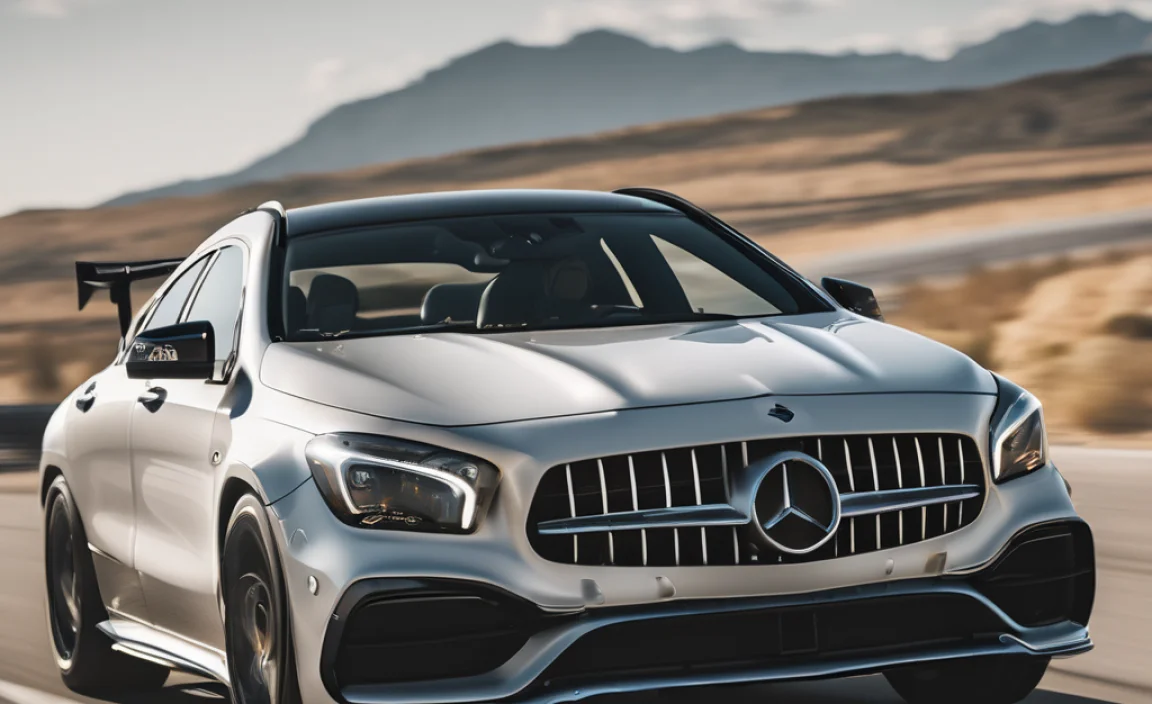GLA-Class Throttle Response: Proven Performance Boost
Upgrading your GLA-Class throttle response is easier than you think! We’ll show you how to achieve a snappier, more engaging driving experience with simple, DIY-friendly methods. Get ready to unlock your Mercedes-Benz’s full potential and enjoy more responsive acceleration on every drive.
Does your Mercedes-Benz GLA-Class sometimes feel a little hesitant when you press the accelerator? You’re not alone! Many drivers wish for a quicker, more immediate reaction from their engine. This common feeling, often referred to as “throttle lag,” can make your driving experience less exciting. The good news is that improving your GLA-Class throttle response is achievable without needing a mechanic. We’ll guide you through proven ways to make your car feel more eager and responsive, giving you a more connected feel to the road. Get ready to unlock a sportier drive!
Understanding Your GLA-Class Throttle Response

Modern cars, including your Mercedes-Benz GLA-Class, use electronic throttle control (ETC) systems, often called “drive-by-wire.” Instead of a direct cable connecting your gas pedal to the engine’s throttle body, there’s a sensor on the pedal that sends a signal to the car’s computer (ECU). The ECU then tells an electric motor on the throttle body how far to open. This system allows for better fuel efficiency, emissions control, and smoother operation.
However, the way the ECU interprets that pedal signal and commands the throttle body can sometimes lead to a noticeable delay. Manufacturers often program these systems to prioritize comfort and fuel economy, which can sometimes mean a less aggressive initial response. This is where improvements can make a big difference!
Why Does Throttle Response Matter?
A car with sharper throttle response feels more agile and engaging to drive. When you want to accelerate, and your car responds instantly, it makes maneuvers like merging into traffic, overtaking, or simply enjoying a spirited drive much more satisfying. It can make your GLA-Class feel more powerful and connected to your inputs.
Common Causes of Sluggish Throttle
- Factory Programming: As mentioned, many cars are tuned for comfort.
- Driving Modes: Your GLA-Class likely has different drive modes (like Eco, Comfort, Sport). Switching to a sportier mode often adjusts throttle mapping.
- Carbon Buildup: Over time, the throttle body can accumulate carbon deposits, restricting airflow and affecting performance.
- System Sensitivities: Sometimes, there’s just room for improvement in how the sensors and ECU communicate.
DIY Solutions for a Snappier GLA-Class Throttle

Let’s dive into the practical steps you can take to enhance your GLA-Class throttle response. We’ll start with the simplest methods and move towards more involved upgrades.
1. Engage Sport Mode (The Easiest Boost!)
Most GLA-Class models come equipped with selectable drive modes. Sport mode is specifically designed to sharpen throttle response, along with other vehicle dynamics. It’s the quickest and easiest way to feel a difference.
How to Activate Sport Mode:
- Locate the drive mode selector button or switch. This is typically on the center console or near the gear shifter.
- Press or turn the selector until “Sport” or “S” is illuminated on your instrument cluster.
- Test the acceleration. You should immediately notice a more direct feel to the accelerator pedal.
Note: While effective, Sport mode also often stiffens the suspension and alters transmission shift points, which might not be ideal for all driving situations. It’s a great temporary fix for a more engaging drive!
2. Clean the Throttle Body
A clogged throttle body can restrict airflow, leading to sluggish performance. Cleaning it is a relatively straightforward DIY task that can restore lost responsiveness.
Tools and Materials You’ll Need:
- Socket set (metric)
- Screwdriver set
- Throttle body cleaner spray (specifically designed for throttle bodies, safe for electronic components)
- Clean rags or shop towels
- Safety glasses
- Gloves
Step-by-Step Throttle Body Cleaning:
- Safety First: Ensure the engine is completely cool. Disconnect the negative terminal of the battery to prevent any accidental electrical issues. Wait about 15-30 minutes after disconnecting the battery.
- Locate the Throttle Body: It’s usually found between the air intake hose and the engine’s intake manifold. You’ll see a relatively large metal component with an electrical connector and intake tubes attached.
- Remove the Air Intake Hose: Loosen the clamps and carefully disconnect the air intake hose from the throttle body. You might need to wiggle it free.
- Access the Throttle Plate: Gently, and with a clean rag wrapped around a finger or a soft tool, try to manually hold the throttle plate open slightly if possible. Important: Do NOT force it or use excessive pressure. Some electronic throttles have a “limp home” mode that can make them resist manual opening. If it doesn’t move easily, do not force it.
- Spray the Cleaner: Using the throttle body cleaner, spray a generous amount onto a clean rag. Then, use the rag to wipe away carbon deposits from the throttle plate (butterfly valve) and the inner walls of the throttle body bore. You can also spray a small amount directly into the throttle body to help loosen stubborn grime, but try to avoid spraying directly onto the electrical components.
- Clean the Plate Edges: Pay special attention to the edges of the throttle plate, as this is where buildup can impede smooth operation.
- Wipe Dry: Use a clean, dry portion of the rag to wipe away any remaining cleaner and loose debris.
- Reassemble: Reattach the air intake hose and secure it with the clamps. Reconnect the negative battery terminal.
- Start the Engine: Start the car and let it idle for a few minutes. The engine might run a bit rough initially as the computer relearns the idle position. A check engine light might temporarily appear, but it often self-corrects after a few drive cycles. If it persists, a diagnostic scan might be needed.
External Resource: For more detailed visual guidance on cleaning throttle bodies in similar Mercedes-Benz models, you can consult automotive repair forums or video tutorials from reputable sources like Autozone or Advance Auto Parts, which often feature step-by-step guides on general maintenance tasks.
3. Install a Throttle Response Controller
This is where you can achieve a significant and easily reversible performance boost. A throttle response controller, sometimes called a “pedal commander” or “throttle booster,” works by modifying the signal sent from your accelerator pedal sensor to the ECU.
How They Work:
These devices plug directly into the accelerator pedal sensor harness. They sit between the pedal sensor and the ECU, intercepting the signal. You can then select different modes that essentially tell the ECU to open the throttle more aggressively for a given pedal input. It doesn’t add horsepower, but it makes the existing power feel much more accessible.
Popular Brands and Features:
When looking for a controller for your GLA-Class, consider brands known for quality and reliability. Some popular options include:
- RaceChip: Offers plug-and-play solutions with user-friendly apps.
- Sprint Booster: A well-established brand known for noticeable improvements.
- Pedal Commander: Highly customizable with multiple acceleration modes.
Pros and Cons of Throttle Controllers
Here’s a quick look at the advantages and disadvantages:
| Pros | Cons |
|---|---|
| Instant and noticeable improvement in throttle response. | Doesn’t add horsepower or torque to the engine. |
| Easy plug-and-play installation, typically reversible. | Can sometimes feel too sensitive if set too aggressively, especially in stop-and-go traffic. |
| Many options offer adjustable settings to suit driver preference. | May void warranty if the dealership detects its use (though they are typically undetectable if removed). |
| Improves the feeling of acceleration and sportiness. | Adds an extra component to the vehicle’s electronics. |
Installation Process (General)
- Safety First: Turn off the ignition and remove the key from the car. Ensure the engine is cool.
- Locate Pedal Sensor: Get down near the accelerator pedal. You’ll find a wiring harness plugged into the pedal assembly.
- Disconnect OEM Connector: Press the release tab on the original wiring connector and pull it straight out from the pedal sensor.
- Connect the Controller: Plug the controller’s male connector into the accelerator pedal sensor, and then plug the female end of the controller’s harness into the original connector you just removed. It should click into place.
- Mount the Controller: Route the controller’s cable neatly and mount the control unit in an accessible location (e.g., under the dash, near the steering wheel) using the provided adhesive pads or zip ties.
- Power On and Test: Turn the ignition on and select your desired mode using the controller’s buttons or app. Test drive carefully to experience the new throttle response.
Important Note: Always follow the specific installation instructions provided by the manufacturer of your chosen throttle response controller. Ensure it’s compatible with your GLA-Class model year.
What About Engine Tuning?

While ECU remapping or tuning (like a “chiptune”) can offer more significant performance gains, including improved throttle response, it’s a more advanced modification. ECU tunes alter various engine parameters, not just throttle mapping.
Engine Tuning vs. Throttle Controllers
It’s crucial to understand the difference:
- Throttle Controllers: These directly alter the signal from the pedal to the throttle. They don’t change the engine’s fundamental power output. They make the car feel more responsive.
- ECU Tuning: This involves reprogramming the engine’s computer to optimize fuel, ignition, boost (if turbocharged), and throttle mapping for more power and responsiveness. This is a deeper modification.
For a beginner looking specifically to enhance throttle response without touching engine internals or risking warranty issues as heavily, a throttle controller is typically the safer and more straightforward choice. For information on ECU tuning, it’s best to consult with reputable tuning specialists who understand Mercedes-Benz ECUs.
Choosing the Right Modification for Your GLA-Class

Deciding which route to take depends on your goals, budget, and comfort level with DIY modifications.
For Beginners:
- Start with Sport Mode: Always the first step.
- Consider Throttle Body Cleaning: Excellent for restoring performance and very budget-friendly.
- Throttle Response Controller: The best option for a noticeable, user-adjustable improvement with minimal effort and risk.
For Enthusiasts Seeking More:
- ECU Tuning: If you desire more power alongside improved throttle response, and are comfortable with the implications for warranty and longer-term engine health.
- Performance Air Filters/Intakes: While not directly throttle response mods, they can slightly improve airflow and combine well with other upgrades.
Frequently Asked Questions (FAQ)
Q1: Will improving throttle response make my GLA-Class faster?
A1: Improving throttle response makes your car feel faster and more eager because it reacts more quickly to your inputs. It doesn’t directly increase the engine’s horsepower or torque, but it makes the existing power more accessible and engaging to use.
Q2: Is it safe to clean my throttle body myself?
A2: Yes, cleaning the throttle body is generally a safe DIY maintenance task for beginners, provided you follow instructions carefully, use the correct cleaner, and disconnect the battery. Be gentle with the throttle plate itself.
Q3: Can a throttle response controller damage my car?
A3: When installed correctly and used within reasonable settings, a quality throttle response controller is very unlikely to cause damage. They simply modify the electronic signal. Always use reputable brands and follow their installation guidelines.
Q4: How long does it take to install a throttle response controller?
A4: Installation is typically very quick, often taking as little as 10-15 minutes for most vehicles, including the GLA-Class, as it’s a simple plug-and-play process.
Q5: Will cleaning the throttle body fix a check engine light?
A5: A dirty throttle body can sometimes cause a check engine light related to idle control or airflow. Cleaning it might resolve the issue. However, if the check engine light persists, it could indicate a different problem, and a diagnostic scan would be necessary.
Q6: Are there any downsides to always driving in Sport Mode?
A6: While fun, Sport Mode often results in slightly lower fuel economy and can cause increased wear on components like the transmission and brakes due to more aggressive driving dynamics. It’s best used for spirited driving rather than all the time, especially in heavy traffic.
Q7: Where can I buy a throttle response controller for my GLA-Class?
A7: You can purchase throttle response controllers from online automotive retailers, directly from the manufacturers’ websites (like RaceChip, Sprint Booster, Pedal Commander), or through large auto parts chains.
Conclusion: Enjoy a More Responsive GLA-Class
Tackling your GLA-Class throttle response is a rewarding project that can dramatically enhance your driving enjoyment. Whether you opt for the instant gratification of an electronic throttle controller, the maintenance virtue of cleaning your throttle body, or simply engaging Sport Mode, you can achieve a significantly more responsive and engaging driving experience. These methods are beginner-friendly, affordable, and effective ways to make your Mercedes-Benz feel more alive under your fingertips. So, go ahead, try these proven performance boosts, and rediscover the joy of a quick-reacting vehicle!